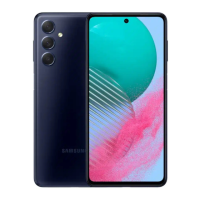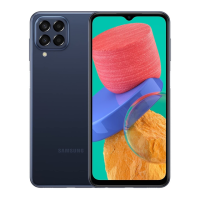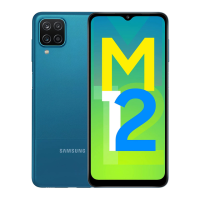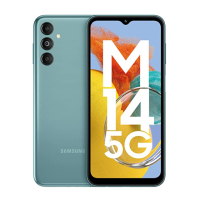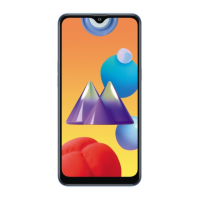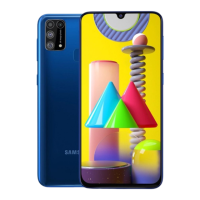Do you have a question about the Samsung Galaxy M51 and is the answer not in the manual?
Essential introductory guidelines, warnings, and icons for safe device usage.
Explains causes of device overheating and provides troubleshooting steps.
Illustrates external components and explains hard keys, soft buttons, and usage precautions.
Covers charging the battery, reducing consumption, and fast charging features.
Instructions for installing, managing, and using SIM and memory cards.
Covers turning the device on/off, initial setup, and emergency mode.
Steps to create, sign in, and manage your Samsung account.
Guides on transferring data wirelessly or via computer using Smart Switch.
Explains touchscreen control, gestures, and navigation bar functions.
Guides on downloading apps from Galaxy Store/Play Store and managing installations.
Introduces Bixby Vision for image recognition, translation, and QR code scanning.
Covers making calls, managing contacts, and blocking numbers.
Instructions for sending, viewing, sorting, and blocking messages.
How to navigate websites, use bookmarks, and manage tabs in the Internet app.
Covers taking photos, videos, different shooting modes, and editing.
Overview of viewing and managing photos/videos, albums, and stories.
Explains AR Emoji, AR Doodle, and sticker creation for creative content.
Managing Always On Display and running apps in split-screen or pop-up view.
Settings for Wi-Fi, Wi-Fi Direct, Bluetooth, NFC, and mobile data.
Customizing sound modes, ringtones, notification settings, and app badges.
Adjusting display brightness, screen modes, wallpapers, themes, and lock screen options.
Setting up face recognition, fingerprints, and managing security features.
Configuring privacy, location permissions, and managing accounts/backups.
Activating advanced features, optimizing device, and managing battery/storage.
System settings like language, reset, and accessibility options.
Updating device software and accessing the user manual for help.
Solutions for lock code prompts, network errors, freezing, and battery problems.
Resolving camera launch errors, poor photo quality, and file playback issues.
Addressing Bluetooth issues, connection problems, and data loss prevention.
Information on hearing aid compatibility regulations and testing.
| Screen shape | Flat |
|---|---|
| Display diagonal | 6.7 \ |
| Touchscreen type | Capacitive |
| Display resolution | 1080 x 2400 pixels |
| Native aspect ratio | 16:9 |
| Rounded display corners | Yes |
| Display number of colors | 16 million colors |
| Processor cores | 8 |
| Processor family | - |
| Processor frequency | 2.2 GHz |
| User memory | 106 GB |
| RAM capacity | 6 GB |
| Compatible memory cards | MicroSD (TransFlash) |
| Maximum memory card size | 512 GB |
| Internal storage capacity | 128 GB |
| Rear camera type | Quad camera |
| Front camera type | Single camera |
| Front camera flash | No |
| Maximum frame rate | 30 fps |
| Video recording modes | 2160p |
| Rear camera aperture number | 1.8 |
| Resolution at capture speed | 3840x2160@30fps |
| Video capture resolution (max) | 3840 x 2160 pixels |
| Rear camera resolution (numeric) | 64 MP |
| Front camera resolution (numeric) | 32 MP |
| Third rear camera aperture number | 2.4 |
| Second rear camera aperture number | 2.2 |
| Third rear camera resolution (numeric) | 5 MP |
| Second rear camera resolution (numeric) | 12 MP |
| Second rear camera field of view (FOV) angle | 128 ° |
| 4G standard | LTE-TDD & LTE-FDD |
| 3G standards | WCDMA |
| SIM card type | NanoSIM |
| Wi-Fi standards | 802.11a, 802.11b, 802.11g, Wi-Fi 4 (802.11n), Wi-Fi 5 (802.11ac) |
| Bluetooth version | 5.0 |
| 3G bands supported | 850, 900, 1900, 2100 MHz |
| 4G bands supported | 700, 800, 850, 900, 1800, 1900, 2100, 2300, 2500, 2600 MHz |
| SIM card capability | Dual SIM |
| Mobile network generation | 4G |
| USB version | 2.0 |
| USB connector type | USB Type-C |
| Headphone connectivity | 3.5 mm |
| Multimedia Messaging Service (MMS) | Multimedia Messaging Service (MMS) is a standard way to send messages that include multimedia content to and from a mobile phone over a cellular network |
| Form factor | Bar |
| Product color | White |
| Audio formats supported | 3GA, AAC, AMR, AWB, FLAC, IMY, M4A, MID, MIDI, MP3, MXMF, OGG, OTA, RTTTL, RTX, WAV, WMA, XMF |
| Video formats supported | 3G2, 3GP, ASF, AVI, FLV, M4V, MKV, MP4, WEBM, WMV |
| Platform | Android |
| Talk time (3G) | - h |
| Battery capacity | 7000 mAh |
| Browsing time (4G) | 23 h |
| Browsing time (Wi-Fi) | 24 h |
| Continuous audio playback time | 182 h |
| Continuous video playback time | 34 h |
| Body SAR (EU) | 1.446 W/kg |
| Head SAR (EU) | 0.609 W/kg |
| Extremities SAR (EU) | 2.44 W/kg |
| Repairability index | 5.6 |
| Depth | 9.5 mm |
|---|---|
| Width | 76.3 mm |
| Height | 163.9 mm |
| Weight | 213 g |
